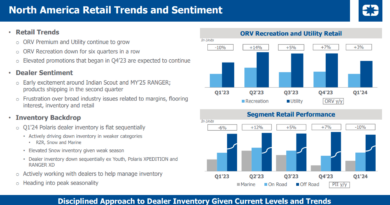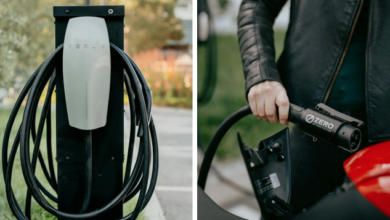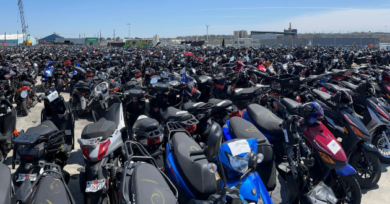Nov. 2, 2009 – Forecasting 2010 scooter sales
By Neil Pascale
Editor
As ho-hum as stability can be, those in the scooter market would probably cherish such an occurrence for 2010 after two tumultuous years.
Scooter retail sales rode the gas price hikes in 2008 to record levels then fell just as far, and then further, this year as prices at the pump normalized and consumer lending requirements tightened.
“As great as last year was on the demand side, we weren’t able to meet the demand in some cases, so that was frustrating,” KYMCO USA President Eric Bondy said, mirroring what others in the scooter market have expressed. “And then you get into this year and we’re not seeing anywhere near the demand that we saw last year.”
For 2010, can retail scooter sales return to levels seen before the considerable ups and downs of the past two years? For the most part, executives in the scooter market believe that’s a realistic goal.
“It’s been a wild ride, hasn’t it?” said George Simone of scooter manufacturer Schwinn Motor Sports.
Wild enough that scooters were at one point a rarity in manufacturers’ inventory — much less dealer showrooms — in the summer of 2008 after the sudden surge in consumer demand. That fell off considerably in the first half of this year, with retail sales down more than 67 percent. Through the first three quarters of 2009, scooter sales remain down more than 60 percent.
Scooter industry officials believe the sudden sales decline is due not only to the stability of gas prices and then the sudden collapse of consumer confidence but also the squeezing of retail lending requirements.
“I can’t tell you how many dealers I talked to who said that when people came into purchase, they just couldn’t finance them,” Simone said, noting Schwinn has taken steps to improve its dealers’ financing options by recently agreeing to a new retail lending deal with Sheffield Financial.
Philip McCaleb, the owner of manufacturer Genuine Scooter Co., also believes the redefining of consumer lending requirements had a huge impact on retail sales. However, McCaleb thinks the uncertainty of the economy and the resulting consumer fear that generated led to the biggest segment of the market — those who purchase scooters as a want rather than a need — largely disappearing for stretches in 2009.
“I still think the mass appeal for scooters is largely fun and lifestyle, but this year we saw a very specific change in the number of people who wanted them as alternative to their car or second car,” he said.
The latter group, however, isn’t generally the ones who are buying the higher-displacement models.
“The people who were purchasing from small to big (displacement scooters) stopped reaching into their pocket,” McCaleb said. “The 250cc and up segment is really, really crowding people’s inventories.”
Difficult comparison
Bondy at KYMCO USA said he “can’t point to a pattern this year where one segment is better or worse off than another sector.”
Part of the difficulty in tracking segment performance — low vs. high displacement — is the difficult comparison to 2008. Bondy said inventory level shortages led some consumers to purchase models that they probably wouldn’t have otherwise selected if dealers had normal inventory levels.
“If you wanted a 150, you would have bought whatever was available last year,” he said.
Before the gas price hikes and the resulting 2008 sales boom, retail scooter sales as reported by the Motorcycle Industry Council (MIC) were relatively stable. In 2007, more than 54,000 scooters were sold in the United States by MIC-reporting companies. That was nearly identical to the prior year.
Will the industry return to those retail sales numbers next year, even if a fair amount of those sales turn out to be 2009 models?
“I really would hope we get there,” Simone of Schwinn said. “I don’t really see any reason why not.
“If you said, ‘Are we going to get back to 2008 numbers?’ I probably would be a little less optimistic there because that was such an extraordinary year.”
McCaleb of Genuine notes some dealers might struggle maintaining healthy profit margins early next year as 2009 product works itself through the retail pipeline.
Bondy of KYMCO USA believes he sees enough positive signs in the economy to be cautiously optimistic about 2010 but also notes the difficulty OEMs are having in forecasting 2010 retail demand. “When you forecast, you usually do some form of history to determine what’s going to happen in the future,” he said.
That’s easier said than done after the past two crazy years in the scooter market.




